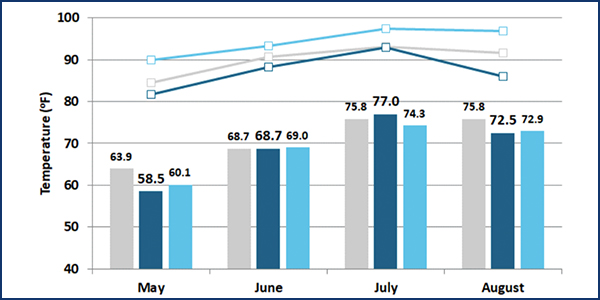The New York Control Area summer peak load of 30,397 MW on July 20 fell below the 50/50 projection for the sixth consecutive summer, Operations Vice President Wes Yeomans told the Management Committee on Wednesday.
The summer 2019 50/50 forecast was 32,382 MW, while actual peak load last summer was 31,861 MW.
“Things were relatively easy for the NYISO this summer, operationally speaking, with two heat waves, on July 18-21 and July 29-30,” Yeomans said. He noted there were four days with peak loads over 30,000 MW.
“We did go into this summer knowing this was the last summer we’d have six nuclear plants,” he said, referring to next spring’s phased shutdown of the first of the two reactors at Indian Point, with the second unit to be decommissioned in 2021.
Yeomans noted that NYISO termed the July 29-30 period as “hot weather operations” on his slides, as the heat has to last three days to be classified a heat wave.
NYISO recorded the all-time peak for a Sunday on July 21 at 30,339 MW and met reliability criteria with surplus operating margins, with no emergency activations and no need for statewide supplemental capacity commitments, he said.
“Prior to July 18, transmission owners rescheduled a lot of their transmission work in anticipation of the heat wave,” Yeomans said. “And it was hot, with heat indexes as high as 110 degrees [Fahrenheit] over the weekend [July 18-21].”
Daily mean temperatures were above the 20-year average in July, near average in June and August, and below average in May, with Albany posting 12 days with highs above 90 F.
Staff Transitions
CEO Rich Dewey mentioned a couple of “public service announcements,” saying the NYISO Board of Directors’ search is underway to fill the upcoming vacancy of Robert Hiney, who is set to leave in April 2020.
The board also approved the appointment of Robb Pike as vice president of market operations, Dewey said. Pike worked for NYISO’s legacy organization, the New York Power Pool, and moved to the ISO at its inception in 1999.
Parallel Testing of EMS/BMS
NYISO hopes to go live with a new energy management system (EMS) and business management system (BMS) at the end of October and is operating a parallel testing phase through Oct. 7.
“That application is receiving all the telemetry that our legacy system is receiving and is doing everything but sending dispatch signals,” Chief Information Officer Doug Chapman said.
The testing is an important phase, with EMS/BMS “running pretty well” except for a few issues that need to be resolved with vendor ABB before going live in October, he said.
If NYISO decides to proceed with the new EMS/BMS, it will move into parallel operations for two weeks in mid-October, double-staffing the control room, Chapman said.
The cutover date is currently targeted for Oct. 22. NYISO’s last opportunity to switch to EMS/BMS in 2019 will be Oct. 31, which is the latest NYISO can cut over to the new system and still issue a necessary System and Organization Controls report to stakeholders by the deadline of Jan. 15, 2020.
“If we miss, the next opportunity to go live is March 1, and that delay has cascading impacts to our 2020 plans,” Chapman said.
The ISO also is replacing the tool used to model the electric system, he said.
Draft 2020 Budget
Alan Ackerman, of Customized Energy Solutions and chair of the Budget and Priorities Working Group, delivered budget highlights.
NYISO’s draft 2020 budget totals $168 million allocated across a forecast of 154.3 million MWh, for a Rate Schedule 1 charge of $1.089/MWh. Comparatively, the 2019 budget was $168.2 million allocated across 157.1 million MWh for a Rate Schedule 1 charge of $1.071/MWh.
The draft budget would represent a 0.12% decrease in revenue requirement from 2019 and a 1.78% decrease in projected megawatt-hours, for an overall Rate Schedule 1 increase of 1.66%.
Cost avoidance is the main strategy behind keeping the ISO’s budget flat for the fourth year in a row, according to the presentation, with salaries and benefits increasing $500,000 from this year, but employee health insurance plan changes effective for the 2020 plan year projected to avoid additional ISO cost increases of $400,000.
The board will review the draft budget in October ahead of an MC vote on it at the end of the month. The budget will then go to the board for approval at its Nov. 19 meeting.
— Michael Kuser





